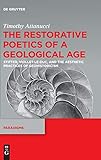The Restorative Poetics of a Geological Age : Stifter, Viollet-le-Duc, and the Aesthetic Practices of Geohistoricism / Timothy Attanucci.
Material type: TextSeries: Paradigms : Literature and the Human Sciences ; 11Publisher: Berlin ; Boston : De Gruyter, [2020]Copyright date: ©2020Description: 1 online resource (VIII, 228 p.)Content type:
TextSeries: Paradigms : Literature and the Human Sciences ; 11Publisher: Berlin ; Boston : De Gruyter, [2020]Copyright date: ©2020Description: 1 online resource (VIII, 228 p.)Content type: - 9783110685534
- 9783110689518
- 9783110689471
- 809/.933580904 23
- PN50 .A88 2020
- PN50 .A88 2020
- online - DeGruyter
- Issued also in print.
| Item type | Current library | Call number | URL | Status | Notes | Barcode | |
|---|---|---|---|---|---|---|---|
 eBook
eBook
|
Biblioteca "Angelicum" Pont. Univ. S.Tommaso d'Aquino Nuvola online | online - DeGruyter (Browse shelf(Opens below)) | Online access | Not for loan (Accesso limitato) | Accesso per gli utenti autorizzati / Access for authorized users | (dgr)9783110689471 |
Dissertation Princeton 2012.
Frontmatter -- Acknowledgements -- Contents -- Introduction -- Chapter 1 The Geological Motive: Cultural Critique and Restorative Desire in Stifter’s Early Prose -- Chapter 2 The Summer of Restoration -- Chapter 3 History of a Restorator: Eugène-Emmanuel Viollet-le-Duc -- Chapter 4 Traces of Life: The Limits of Geohistoricism -- Epilogue -- Bibliography -- Index
restricted access online access with authorization star
http://purl.org/coar/access_right/c_16ec
At this moment, the concept of the Anthropocene is challenging us to rethink our relationship to the earth and its history, but we have not yet fully understood the extent to which our knowledge of earth history has shaped the historical culture of modernity. This study examines the relationship of geology — including its central narratives, metaphors, topoi, and other imaginative tools — to the broader historical imagination that has until now been called “historicism.” Two major figures in the rise of historical conservationism and aesthetic historicism in nineteenth-century Europe guide this study of geohistoricism: the Austrian writer, painter, and art conservator Adalbert Stifter, whose novel Der Nachsommer (Indian Summer, 1857) narrates the rise of geohistoricism through the friendship of a geologist and his art-historian mentor; and French architect and conservator Eugène Emmanuel Viollet-le-Duc, whose theoretical/abstract/imaginative understanding of “restoration,” based on the geology of Georges Cuvier, informed his practical approach. These authors reveal how geological thought provides a powerful new way to envision and reconstruct past worlds, even as it also demonstrates the erosive precariousness of our present.
This book examines two mid-nineteenth century thinkers – the Austrian writer Adalbert Stifter and the French architect Eugène E. Viollet-le-Duc – who imagined cultural history on the model of earth history: as a history of objects to be restored and worlds to be reconstructed. The nascent field of geology shaped cultural thought; their conservationism, informed by erosion, envisions a future of restorative renewal.
Issued also in print.
Mode of access: Internet via World Wide Web.
In English.
Description based on online resource; title from PDF title page (publisher's Web site, viewed 25. Jun 2024)


